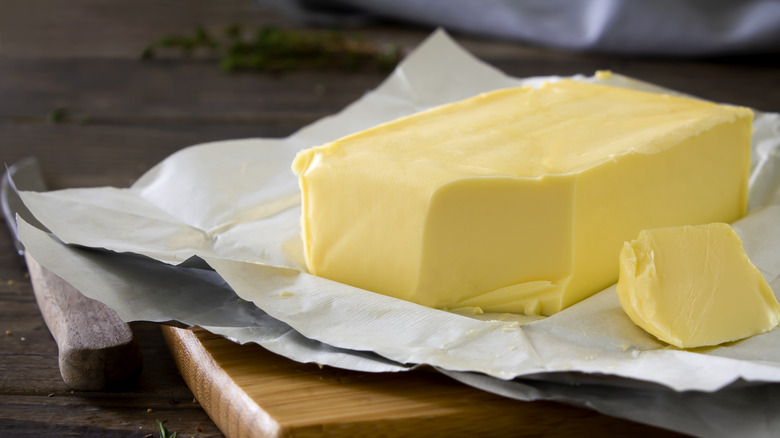Why European Butter Should Be Your Go-To When Baking Bread
Julia Child's love for butter is well-known, and since she learned French cuisine in France, she preferred French butter over American butter. "With enough butter, anything is good," Child once said, and defying the fears that it was bad for people, she used copious amounts – reportedly 753 pounds during four seasons of her show, "Baking with Julia." Butter adds texture and flavor to baked goods, so it makes sense that it would do the same for bread.
Jami Callao, who oversees the pastry and bread programs at Respect Hospitality, is also partial to European butter, which she told Tasting Table "elevates every aspect of the bread from flavor to texture to quality." Like Child, Callao swears by French butter, particularly Plugrà European-style butter, which, as she told us, "has a richer flavor and higher fat content." But is there really a difference between European butter and American butter? Actually, yes, especially with respect to how each is made.
The USDA requires that American butter has a minimum of 80% milkfat, while the European Union mandates that butter must have at least 80% and less than 90% butterfat, which is ideal for all-butter puff pastry, croissants, and pie crusts. As a result, most European butter boasts a fat content of 82% or higher. Color and taste are also different between the two, both of which are affected by how and where the cows were raised. American cows are usually fed corn or soy and produce a pale, neutral-flavor butter, while European cows are pasture-fed, and the butter made from their milk is a deep yellow with grassy flavor overtones.
European butter is perfect for laminated doughs
The high butterfat content in European butter adds a more intense buttery flavor to bread, but it also makes more pockets in the bread, resulting in a softer and more tender crumb. Such an airy texture is what is most desired when making French croissants, or any bread or pastry that requires lamination, which is why Jami Callao says "for laminated doughs, it's a no-brainer." For example, laminating your pie dough — the process of folding and rolling butter into the dough — with European butter will produce an extra-flaky and crisp pie crust.
Some European butters are even cultured, which means that live bacterial cultures have been added to the milk and allowed to ferment before being churned. Cultured butter looks the same as other European butters, but it makes a finer crumb in the bread and adds a more pronounced buttery taste with a slight tang. However, when it comes to butter regulation, France is the most diligent. The country takes the quality of its butter very seriously by labeling the highest grade as PDO (Protected Designation of Origin).
PDO butter must conform to extreme restrictions regarding the quality of the milk, how it's produced, and the region where the cows graze. PDO butter is also very expensive, but less-pricey substitutes are available in the U.S. because Dairy Farmers of America now make European-style butter, including Callao's preferred brand, Plugrà. In addition to a variety of fancy butter brands, there are a number of American-made European-style butters on the market, so it's worth trying out Callao's suggestion of adding European butter to your next batch of bread dough.

